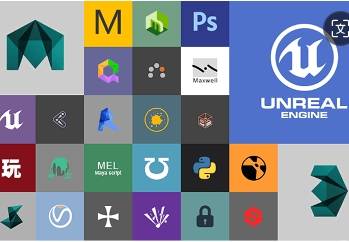Release date:2022, February 10
Duration:07 h 57 m
Author:Stan Prokopenko
Skill level:Beginner
Language:English
Exercise files:Yes
In this course, you will learn the fundamental concepts of drawing, which can be applied to any form of visual art. The course is designed to be engaging, informative, and easy to follow. You will learn how to use the visual language of drawing to communicate with pictures and how to draw from both imagination and reference. The course is divided into different sections, each focusing on a specific aspect of drawing, such as line quality, shape, perspective, form, light and shading. The course also includes projects tailored to beginners and intermediate artists, allowing you to go through the course twice, once as a beginner and once as an intermediate artist. This course will help you build a solid foundation of skills that will be useful for any specialty, whether you are interested in becoming a fine art painter, concept artist, or comic artist.
This course is designed to teach anyone, regardless of experience level, how to draw effectively using visual language. You will learn the most important foundational concepts for drawing anything and will be able to create pictures from both imagination and reference. The course is structured to keep you engaged and motivated, focusing on information, practical exercises, and projects.
The course is divided into two levels: for beginners and those looking to review and improve their foundational skills. This means you can go through the system twice – once as a beginner and again as an intermediate artist.
We will start by building good drawing habits and line quality, then move on to shape and form, learning how to construct 3D shapes intuitively without complex math and grids. We’ll also learn about perspective and how to add light and shading to our drawings by controlling values and edges.
By committing to this course and following along with the projects, you will improve your drawing skills and have a solid foundation that can be applied to any specialty, whether fine art, concept art or comic art. This course is a prerequisite for anyone pursuing a career in the visual arts.
What you will learn
Materials: Learn how to set up with all the right paper, pencils, erasers, pens, and markers. You don’t need anything fancy for this course (just pencil and paper), but the instructor will teach you about the different options available. Lines: Discover how to create tapered strokes and confident lines, vary your line weight, and more to improve your drawing skills. Shapes: Understand how to break subjects into simpler shapes and make your forms more dynamic and exciting. Perspective: Learn the basics of perspective to understand how to draw a box, cylinder, or any simple primitive in 1-point, 2-point, or 3-point perspective. Intuitive Perspective: Instead of learning math and grids, you will do exercises to get comfortable with drawing freehand perspective intuitively, allowing you to construct any 3D object from your imagination. Values: Learn how to correctly see and understand values, which is the first step in learning how to shade. Build up your ability to organize the values in your drawing to represent clear light on form. Edges: Understand the importance of edges and learn how to transition between shapes and values to make your drawings feel three-dimensional and exciting. Curriculum Getting StartedLearning How to Draw
Drawing is a form of visual communication that can be mastered with proper guidance and practice, just like any other language.
7:16Intro to Drawing Basics
In this video, we’ll delve into the content covered in my Drawing Basics course.
9:31Project – Get Your Tools and Start Playing
Before we begin, let’s go over the necessary tools. I’ve provided a comprehensive list of materials, including paper, pencils, markers, erasers, and sharpeners.
6:12Ultimate Guide to Sketchbooks and Paper
A beginner-friendly guide to selecting the right sketchbook and paper. We’ll cover paper types, texture, weight, archivability, and common mistakes to avoid.
14:04Ultimate Guide to Pencils and Erasers
A beginner-friendly guide to choosing the right pencils and erasers. We’ll cover the various types of pencils and erasers available.
16:47Sharpening 6 Types of Drawing Pencils
Learn how to sharpen six different types of drawing pencils, including wooded and woodless graphite pencils, 2.0 and 5.6mm mechanical pencils, charcoal pencils, and eraser pencils.
18:58Project – Simplify from Observation
The first project in the Drawing Basics course is to simplify the shapes, edges, and values of a pear or portrait from observation.
5:36Demo – Simplify Pear from Observation
In this step-by-step demo, I’ll show you how to properly complete the first assignment for level 1 students.
24:58Demo – Simplify Portrait from Observation
In this step-by-step demo, I’ll show you how to properly complete the first assignment for level 2 students.
48:45Critique – Simplify Pear from Observation
In our first critique session, I’ll review submissions of the simplified pear and offer feedback on common mistakes.
9:30Critique – Simplify Portrait from Observation
I’ll be reviewing submissions of the simplified portrait and providing tips and advice on how to overcome common mistakes.
9:56Mushroom Warmups
This fun warmup exercise will help you practice drawing ellipses.
10:50 LinesIntro to Lines
As an artist, you have countless opportunities to use lines in your work. Let’s dive into the fundamentals.
9:362 Week Drawing Challenge
Take on the challenge of drawing daily for two weeks! See if you can establish a daily drawing routine.
1:02Project – Simplify to CSI
This project is designed to help you refine your lines and eliminate “chicken scratch.” We’ll simplify our drawings to use C curves, S curves, and straight lines.
4:37Demo – Simplify Snail and Boots to CSI
In this demonstration, I will show you my approach to creating level 1 CSl drawings, by simplifying the Snail and Boots images into the basic shapes and forms.
40:52Demo – Simplify Camel and Skull to CSI
In this demo, I’ll guide you through my process of simplifying more complex images, such as the Camel and Skull, into the essential shapes and forms needed for level 2 CSl drawings.
28:29Critique – Simplify to CSI
This session focuses on reviewing and evaluating your submissions for the “Simplify to CSI” task.
52:15How to Draw Confident Lines – The Tapered Stroke
Learn how to create confident, dynamic lines in your sketches by mastering the tapered stroke technique. I’ll show you how to construct complex shapes and add energy to your loose sketches.
5:19Project – Learning to Sketch from Observation
In this project, we’ll start with simple loose lines and practice sketching from observation, gradually building our skills and confidence.
3:44Project – Learning to Sketch from Imagination
This project is the first step in developing your ability to draw from imagination. We’ll explore techniques for creating original, imaginative sketches.
1:21Searching Lines: 3 Levels of Looseness
Explore the importance of drawing from imagination for artists, when to start, and how to overcome the emotional challenges that can arise.
7:24Drawing from Imagination Cramps
Why drawing from imagination is important for artists, when to start, and overcoming the emotional challenges.
9:53Demo – Learning to Sketch from Observation
In this lesson, I will walk you through my process for sketching all three of the “Learning to Sketch from Observation” reference images, providing tips and insights along the way.
50:48Demo – Learning to Sketch from Imagination
Watch me demonstrate the sketching from imagination project, from studying the reference material to exploring different ideas and creating a final sketch.
26:28Update
Critique – Learning to Sketch from Observation
In this lesson, I’ll look over your sketches from observation and address the common mistakes.
11:05Critique – Learning to Sketch from Imagination
Reviewing the common mistakes and standout assignments from the “Learning to Sketch from Imagination” projects.
50:30Warmups to Improve Line Quality
In this lesson, I show you 5 line quality warm-ups that you can practice to improve your line control.
7:356 Habits for Good Line Quality
Master line quality with 6 key habits: avoid common mistakes, find a comfortable speed, follow-through, ghosting, rotate the paper, and use simple strokes.
9:20[Proko] Drawing Basics by Stan Prokopenko (1-29)
01. learning-how-to-draw 02. intro-to-drawing-basics 03. project-get-your-tools-and-start-playing 04. ultimate-guide-to-sketchbooks-and-paper 05. ultimate-guide-to-pencils-and-erasers 06. sharpening-6-types-of-drawing-pencils 07. project-simplify-from-observation 08. simplify-from-observation-pear-demo 09. simplify-from-observation-portrait-demo 10. simplify-from-observation-pear-critique 11. critique-simplify-portrait-from-observation 12. mushroom-warmups 13. intro-to-lines 14. 2-week-drawing-challenge 15. project-simplify-to-csi 16. demo-simplify-snail-and-boots-to-csi 17. demo-simplify-camel-and-skull-to-csi 18. critique-simplify-to-csi 19. how-to-draw-confident-lines-the-tapered-stroke 20. project-learning-to-sketch-from-observation 21. project-learning-to-sketch-from-imagination 22. searching-lines 23. is-it-too-early-to-draw-from-imagination 24. demo-learning-to-sketch-from-observation 25. demo-learning-to-sketch-from-imagination 26. critique-learning-to-sketch-from-observation 27. critique-learning-to-sketch-from-imagination 28. warmups-to-improve-line-quality 29. 6-habits-for-good-line-quality Resources (1-23).7z Resources.7z [Proko] Drawing Basics by Stan Prokopenko (1-29)_Subtitles.7z
 Channel and
Channel and  Group
Group
1、登录后,打赏30元成为VIP会员,全站资源免费获取!
2、资源默认为百度网盘链接,请用浏览器打开输入提取码不要有多余空格,如无法获取 请联系微信 yunqiaonet 补发。
3、分卷压缩包资源 需全部下载后解压第一个压缩包即可,下载过程不要强制中断 建议用winrar解压或360解压缩软件解压!
4、云桥网络平台所发布资源仅供用户自学自用,用户需以学习为目的,按需下载,严禁批量采集搬运共享资源等行为,望知悉!!!
5、云桥网络-CG数字艺术学习与资源分享平台,感谢您的赞赏与支持!平台所收取打赏费用仅作为平台服务器租赁及人员维护资金 费用不为素材本身费用,望理解知悉!



评论(0)